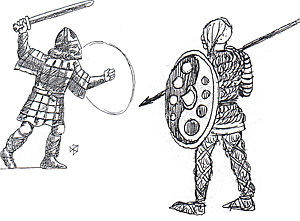
Since Tony Bath published "Hyboria, The Campaign that Grew" in "Battle", I have always wanted to run my own world. At one time I had a half share in one named "The Badlands", but that universe disappeared some time ago. Last year I began the groundwork to set one up. Originally it was planned that new tactical rules would be developed for it, but in the end I purchased a set of "Hordes of the Things" and wrote a campaign supplement to customise it for my personal use. As well as HoTT the rules are suitable for DBA and its derivatives.
SWORD AND SORCERY TACTICAL RULES
TERRAIN.
The width of the table in field actions is determined by the size of the largest army present and is 60cm per 24 AP or fraction of 10 to 23, the depth is unchanged. If the player wishes then he can create a terrain generation system, but I decided against this on the grounds that it was not worth going to so much trouble for very little real gain. Instead I created guidelines and lay out the terrain as I feel at the time. It should be noted that if the battle is being fought in a forest square/hex then the battlefield will be covered in woods, swamp if swamp, gentle hill if hilly and steep hills if mountainous.
Good going: Grassland/open, brush, gentle hill, gully lengths.
Bad going: Woods, swamp, built-up areas, fields, steep hills, gully sides, dunes.
Impassable: Cliffs, dense woodland, ponds.
Blocking visibility: Hills, built-up areas, woods, dense woodland, in a gully, below cliffs.
Aerials may not land on woods, built-up areas or dense woodland. They can see over one contour hill, unfortified built-up areas, woods not in a forest hex and into gullies.
COMMAND CONTROL.
As the battle is part of a campaign then it goes without saying that the character of the CinC and his subordinates will play an important part. If you are using Tony Baths' characterisation generation system (or a derivation of it) then you may have to modify my system below. Although it was originally based on Tony's with some input from work by Steve Turner, there are a number of differences.
Firstly Mister Average is twice as lightly, per se, to appear than anyone else. Secondly the tactical and the strategic competence of a leader in the art of war are not assumed to be the same. Thirdly I number in reverse order. The main reasons for the latter appear in my strategic rules where the strategic rating and its square are of importance.
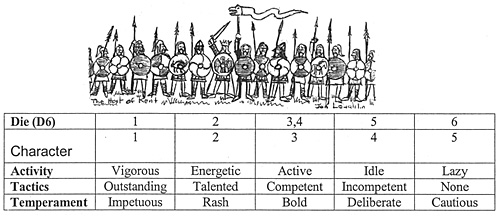
An army or contingent without a leader must nominate a unit commander as its general. The nominee has a competence of 5; an activity as above; and temperament as above, but the highest of 2D. It functions as a normal general element with respect to command ranges and victory.
If more than one leader is present then each may be given a command which dices for its own PIPs. Generals should not command more than 24 APs unless there is insufficient leaders. A leader is a character who is eligible to command troops.
- Tactical Competence : Dice
1 Brilliant : Highest of three
2 Competent : Highest of two
3 Average : One
4 Incompetent : Lowest of two
5 None : Lowest of three
If multiple dice are thrown then one must be distinctive and is used for command morale, desorcing and arrival of gods and dragons. If you wish, you may allow natives to treat a particular variety of bad going as good with respect to PIPs, e.g. elves in woods, mountain men and dwarves on steep slopes. This permits the units in question to move in groups instead of singly.
Demoralised units or groups of units may be moved on 1 PIP irrespective of unit type or distance from the commander.
TIME OF DAY.
Sunrise is 2, noon at 7 and sunset is 12. Every four turns on to battlefield in summer, every three in spring or autumn equal one hour. Dawn is 1 to 2, dusk 12 to 13. The score of the lowest two of 3D is the hour when the battle starts, DM for each CinC -2, vigorous, -1 energetic, 0 active, +1 idle, +2 lazy; minimum score 2.
WEATHER.
If rivers have been flooded then only mounted and aerials may cross rivers unless rafts have been prepared.
If the weather for the month is heavy rain or snow then all movement except fording a river is reduced by 100p.
If there are high winds then aerials move at 2/3 normal speed.
If the weather for the month is rain (or snow) then dice each attacker's bound, rain falls on 6, DM +1 if heavy rain. It will then stop on 1 in the attacker's bound, no DM. If rain is falling then command ranges are reduced to 300p irrespective of whether in line of sight or not.
If there is a drought then there is no penalty for crossing a river. There is still a tactical DM for defending its banks.
DEPLOYMENT AND ORDERS.
After writing and fighting with "Programmed Wargames" by Charles Grant I created a number of general purpose programs for use with other scenarios. The two which have most use in a campaign battle are Attack/Deployed and Defence/Linear Terrain so I have listed them below. If neither are suitable for your purpose then you can borrow one of Charles' or write your own. If one army is defending then deploy it first, if neither are then deploy the army led by the least competent CinC with terrain replacing defender's disposition. Deploy first, move second. If marked * then DM -1 if CinC is deliberate or cautious, +1 CinC is rash or impetuous; 0=1, 7=6.
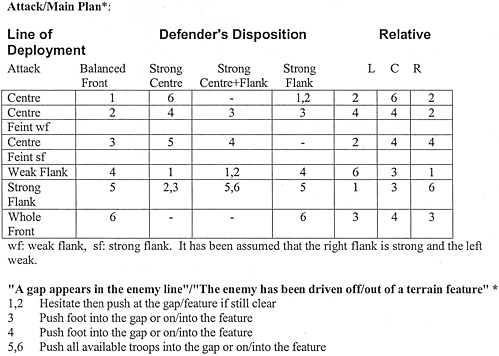
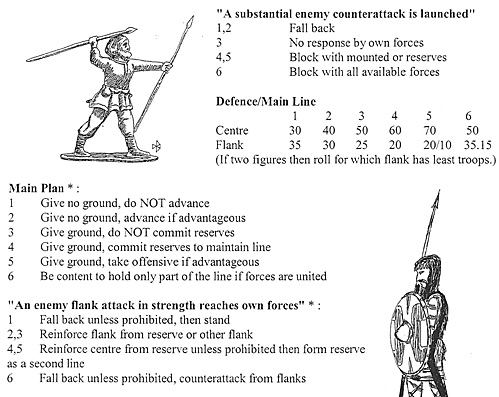
VICTORY.
An army which has lost all generals or half its APs, and has also lost more AP than the other, or which has lost its stronghold, is demoralised. A command which has lost its general is demoralised if its next PIP die is not greater than half its AP currently lost. Demoralised troops must flee the battlefield. If its orders permit it to do so then any army may verbally admit defeat and walk off the battlefield at any time. Heroes and paladins may not then leave the battlefield if other units except strongholds still remain on it except by a combat result. A victorious general may order units to pursue the enemy, roll equal or less than temperament not to. Pursuing units continue to do so until the end of dusk or until they lose contact off table.
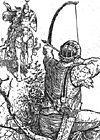 CASUALTIES.
CASUALTIES.
Destroyed and ensorced units are recovered on 4+ if victorious, 5+ if not; DM +1 if ensorced, +1 if in home territory. Units which leave the table return to their force the following day.
Afternote:
A few trial runs with these rules will demonstrate that a more capable general will outmanoeuvre one who is less capable but commands a larger force. The cautious incompetent will sit and watch the enemy slaughter the rest of the army, then pack up and go home. The rash leader will charge with his men along the path of glory, and death if he is a few bricks short of a full load. And if you wish to fight during the winter do not be surprised if night falls before one side is vanquished.
Back to Table of Contents -- Lone Warrior # 149
Back to Lone Warrior List of Issues
Back to MagWeb Magazine List
© Copyright 2005 by Solo Wargamers Association.
This article appears in MagWeb.com (Magazine Web) on the Internet World Wide Web.
Other articles from military history and related magazines are available at http://www.magweb.com
